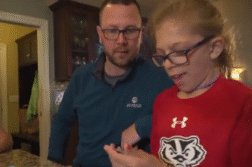PALO ALTO, Calif. (Ivanhoe Newswire) — The tiniest of tiny, preemies, weighing in at three, two, even one pound are being born, surviving and thriving. The youngest baby to survive was born at just 21 weeks. Baby James is now in his mid-20’s and perfectly healthy. Any baby born before 37 weeks is considered premature. Right now, there’s no telling which moms will deliver early and which ones will go the full 40 weeks. But soon a simple blood test may be able to pinpoint a due date and save little lives. predicting preemies
You could say Haven and his mom are both heroes.
Haven’s mother Amanda Smith said, “I tell people this is like a war zone, only this time it’s not my life on the line, it’s my little innocent child’s.”
Smith, an Iraq and Afghanistan war vet and NATO medal of honor recipient, gave birth to Haven 100 days early, weighing just nine-tenths of a pound.
“It’s about the size of coke can,” Smith said.
Haven is one of 450,000 babies in the U.S. born prematurely each year. For two-thirds of those deliveries, no one knows why.
Mira Moufarrej, a Bioengineering PhD Student at Stanford University said, “When people think about what tools an obstetrician has right now to look at a pregnancy, it’s ultrasound and that’s it.”
Now bioengineers at Stanford have developed a blood test that detects with 80 percent accuracy who will deliver early. Something that ultrasound cannot do.
Moufarrej explained, “it tells you more about what’s going on in the process of building a baby and what might go wrong.”
The test looks at RNA molecules found in the mother’s blood.
“Looking at those seven types of RNA molecules, they’re higher in women who deliver preterm than full-term,” Moufarrej said.
The team hopes doctors will then be able to start treatments that will delay delivery. Haven spent the first 241 days of his life in the hospital, has had seven surgeries since birth, he’s on oxygen and takes 18 syringes of medication daily. But as his mom says, he’s a fighter.
Smith said to Haven, “I get to watch you stand up, smile, and give people hope.”
In low-resource settings, a test to predict time to delivery has tremendous potential to impact women’s health particularly for disadvantaged women with limited access to hospitals. Because a blood test is cheap and easy to use, it has the potential to complement ultrasound and expand access to good prenatal care. Amanda is documenting little Haven’s journey. You can follow them both on Facebook at https://m.facebook.com/TeamHavenGreyson/
Contributors to this news report include: Marsha Lewis, Field Producer; Evan Boarders, Videographer; Cyndy McGrath, Supervising Producer; Roque Correa, Editor.
To receive a free weekly e-mail on Medical Breakthroughs from Ivanhoe, sign up at: http://www.ivanhoe.com/ftk
MEDICAL BREAKTHROUGHS
RESEARCH SUMMARY
TOPIC: PREDICTING PREEMIES: BUILDING HEALTHIER BABIES
REPORT: MB #4664
BACKGROUND: When a baby is born more than three weeks earlier than the predicted due date, that baby is called “premature.” Premature babies (preemies) have not grown and developed as much as they should have before birth. Most of the time, doctors don’t know why babies are born early. When they do know, it’s often because a mother has a health problem during pregnancy, such as diabetes, hypertension, heart or kidney problems, and an infection of the amniotic membranes or vaginal or urinary tracts. Other reasons why a baby may be born early include bleeding, often due to a low-lying placenta or a placenta that separates from the womb, having a womb that isn’t shaped normally, carrying more than one baby, being underweight before pregnancy or not gaining enough weight during pregnancy, or mothers who smoke, use drugs, or drink alcohol while pregnant.
(Source: https://kidshealth.org/en/parents/preemies.html)
TREATMENT: Predicting a premature baby could help doctors execute treatment options that may delay delivery. Mira Moufarrej, a Bioengineering PhD Student at Stanford University said, “They use ultrasound to estimate in the first trimester how long the baby is. And they know that in the first trimester the relationship between the length of the baby now and due date is a linear relationship. Now if you measure the baby in the second trimester or the third trimester, that’s not necessarily the case because at that point differences in humans come into play.” Moufarrej says there are a few treatments, but they do not work well. “You can do progesterone injections during pregnancy. And then if a woman has a short cervix then you can do a cervical circlage. But there’s a narrow group of women that fit that scope and who deliver preterm, and they haven’t been shown to be that effective.”
(Source: Mira Moufarrej)
NEW TESTS: Moufarrej talked about the blood tests, “So we developed two blood tests. The first one predicts gestational age similar to ultrasound, so when a baby will be due, but it does it in the second and the third trimester as opposed to the first. So, for women who live far away from the clinic or women who don’t know they’re pregnant until later in life, this serves as a complement and a substitute whereas in the past there was no substitute to ultrasound.” The test had so far shown 80 percent accuracy.
(Source: Mira Moufarrej)
FOR MORE INFORMATION ON THIS REPORT, PLEASE CONTACT:
Samantha Beal
Director, Media and Public Relations
650-498-7056
If this story or any other Ivanhoe story has impacted your life or prompted you or someone you know to seek or change treatments, please let us know by contacting Marjorie Bekaert Thomas at mthomas@ivanhoe.com




